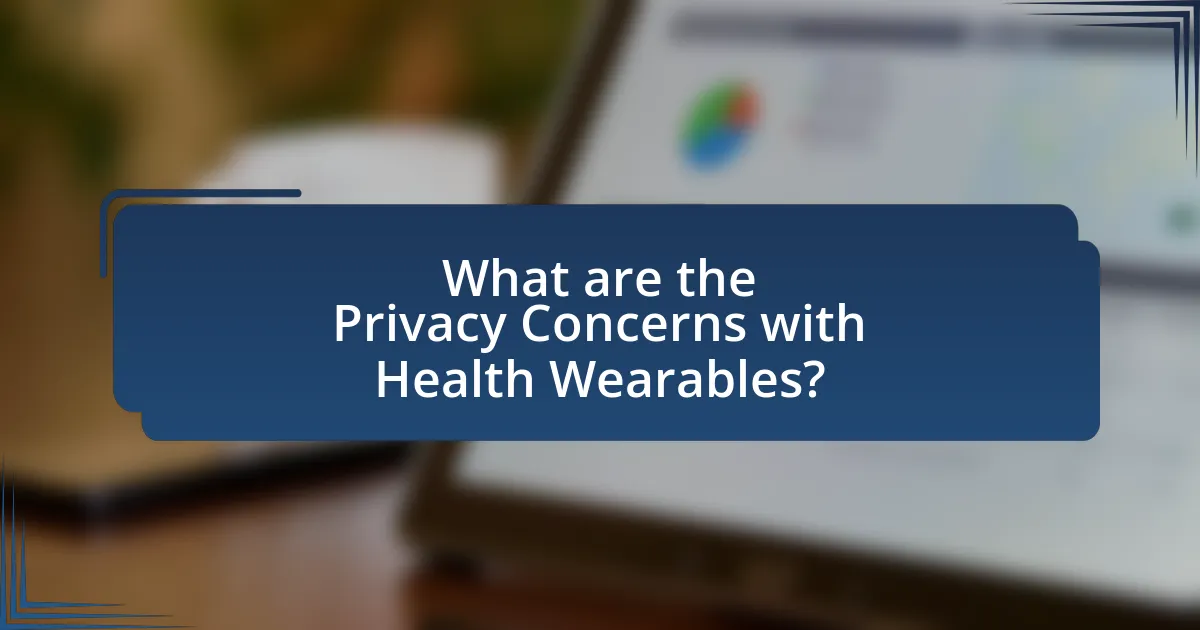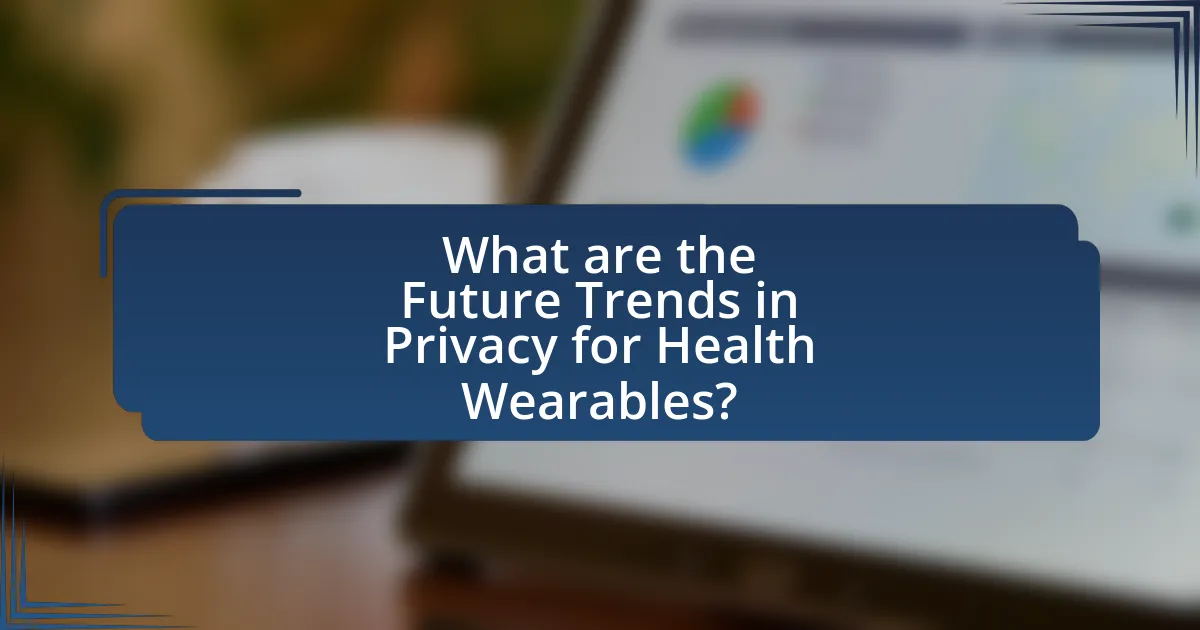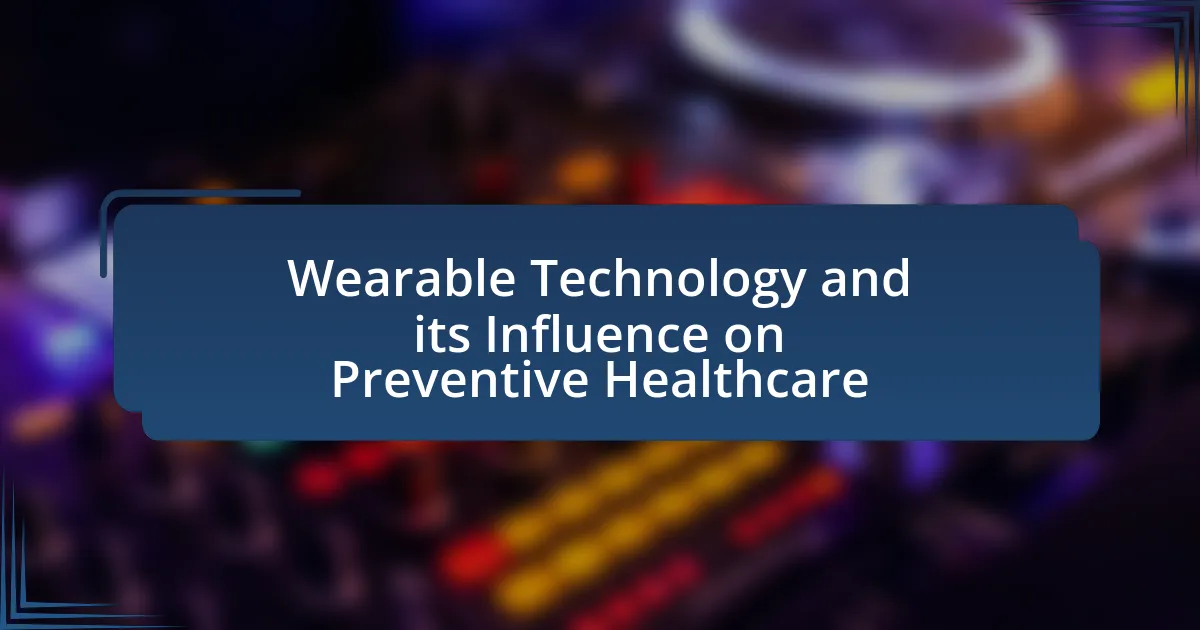Health wearables, which collect sensitive personal health data such as heart rate, sleep patterns, and location, raise significant privacy concerns due to the potential for unauthorized access and data breaches. The article examines how these devices gather and transmit personal information, the types of data collected, and the risks associated with data breaches, including identity theft and discrimination. It also discusses the importance of data privacy regulations like HIPAA and GDPR, the role of manufacturers in ensuring data security, and user responsibilities in managing privacy settings. Additionally, the article highlights future trends in privacy protection for health wearables, including advancements in encryption and user-controlled data sharing.

What are the Privacy Concerns with Health Wearables?
Health wearables pose significant privacy concerns primarily due to the sensitive health data they collect and transmit. These devices often gather personal information such as heart rate, sleep patterns, and location, which can be vulnerable to unauthorized access or data breaches. For instance, a 2020 report by the Identity Theft Resource Center indicated that health data breaches increased by 25% from the previous year, highlighting the risks associated with storing and sharing health information. Additionally, many wearables share data with third-party applications, raising concerns about how this information is used and whether users have adequate control over their data.
How do health wearables collect personal data?
Health wearables collect personal data through sensors and algorithms that monitor physiological metrics such as heart rate, sleep patterns, and physical activity. These devices utilize technologies like accelerometers, gyroscopes, and optical sensors to gather real-time data, which is then processed and transmitted to connected applications for analysis. For instance, a study published in the Journal of Medical Internet Research indicates that wearables can track over 30 different health metrics, providing insights into users’ health and fitness levels.
What types of data do health wearables typically gather?
Health wearables typically gather biometric data, activity data, and environmental data. Biometric data includes heart rate, blood pressure, and sleep patterns, which are essential for monitoring health conditions. Activity data tracks steps taken, calories burned, and exercise duration, providing insights into physical fitness levels. Environmental data may include temperature and air quality, which can affect overall health. These types of data are crucial for users to manage their health effectively and for healthcare providers to offer personalized care.
How is this data transmitted and stored?
Data from health wearables is transmitted through wireless communication protocols such as Bluetooth, Wi-Fi, or cellular networks. These protocols enable the devices to send collected health metrics, like heart rate or activity levels, to paired smartphones or cloud servers for storage and analysis. For instance, a study by the Journal of Medical Internet Research highlights that data is often encrypted during transmission to protect user privacy. Once transmitted, the data is typically stored in secure cloud environments, where it is protected by various security measures, including encryption and access controls, to prevent unauthorized access.
Why is data privacy important for health wearables?
Data privacy is crucial for health wearables because these devices collect sensitive personal health information that can be misused if not properly protected. The data gathered by health wearables, such as heart rate, activity levels, and sleep patterns, can reveal intimate details about an individual’s health status and lifestyle. If this information falls into the wrong hands, it could lead to identity theft, discrimination, or unauthorized surveillance. For instance, a study by the Pew Research Center found that 60% of Americans are concerned about how their health data is used by companies, highlighting the widespread apprehension regarding data misuse. Therefore, ensuring robust data privacy measures is essential to protect users’ health information and maintain their trust in health wearable technologies.
What are the potential risks of data breaches?
Data breaches pose significant risks, including identity theft, financial loss, and unauthorized access to sensitive personal information. Identity theft can occur when personal data, such as Social Security numbers or financial details, is exposed, leading to fraudulent activities. Financial loss may arise from direct theft or the costs associated with mitigating the breach, such as legal fees and credit monitoring services. Additionally, unauthorized access to sensitive health information can result in privacy violations and discrimination, particularly in employment or insurance contexts. According to a 2020 report by IBM, the average cost of a data breach is $3.86 million, highlighting the financial implications for organizations and individuals affected by such incidents.
How can unauthorized access to health data affect individuals?
Unauthorized access to health data can lead to significant personal harm for individuals, including identity theft, discrimination, and emotional distress. When sensitive health information is exposed, it can be exploited by malicious actors for fraudulent activities, such as opening accounts in the victim’s name or accessing medical services. Furthermore, individuals may face discrimination in employment or insurance based on their health conditions, as unauthorized access can reveal pre-existing conditions or genetic predispositions. A study by the Ponemon Institute found that 60% of healthcare organizations experienced a data breach, highlighting the prevalence of unauthorized access and its potential impact on individuals’ lives.
What regulations exist to protect user privacy in health wearables?
Regulations that protect user privacy in health wearables include the Health Insurance Portability and Accountability Act (HIPAA) in the United States, which mandates the protection of personal health information. HIPAA applies to entities that handle health data, ensuring that user information is kept confidential and secure. Additionally, the General Data Protection Regulation (GDPR) in the European Union provides stringent guidelines on data protection and privacy, requiring explicit consent from users for data processing and granting them rights over their personal data. These regulations collectively aim to safeguard user privacy by enforcing strict compliance measures for organizations that collect and manage health data from wearables.
How do laws like HIPAA apply to health wearables?
Laws like HIPAA apply to health wearables by regulating the protection of personal health information collected by these devices. HIPAA mandates that any entity handling protected health information (PHI), including data from health wearables, must implement safeguards to ensure confidentiality, integrity, and security of that information. For instance, if a wearable device transmits health data to a healthcare provider, that provider must comply with HIPAA regulations regarding data privacy and security. Additionally, the U.S. Department of Health and Human Services has clarified that health wearables that collect and share health information may be considered covered entities under HIPAA, thus requiring adherence to its standards.
What role do manufacturers play in ensuring data privacy?
Manufacturers play a critical role in ensuring data privacy by implementing robust security measures and adhering to regulatory standards. They are responsible for designing devices that protect user data through encryption, secure data storage, and regular software updates. For instance, the Health Insurance Portability and Accountability Act (HIPAA) mandates that manufacturers of health-related devices comply with strict privacy and security requirements to safeguard personal health information. Additionally, manufacturers must conduct thorough risk assessments and engage in transparent data practices to build consumer trust and ensure compliance with privacy laws.

What are the User Responsibilities Regarding Privacy?
Users are responsible for actively managing their privacy when using health wearables. This includes understanding the data collection practices of the devices, ensuring that personal information is shared only with trusted applications, and regularly reviewing privacy settings to control data access. For instance, users should read privacy policies to comprehend how their health data is used and stored, as many wearables collect sensitive information that can be vulnerable to breaches. Additionally, users must be vigilant about software updates, as these often include security enhancements that protect personal data.
How can users protect their personal data when using health wearables?
Users can protect their personal data when using health wearables by implementing strong privacy settings and being selective about data sharing. Health wearables often collect sensitive information, so users should review and adjust privacy settings within the device and associated apps to limit data access. For instance, disabling location tracking and opting out of data sharing with third parties can significantly enhance privacy. Additionally, users should regularly update their devices and apps to ensure they have the latest security features, as outdated software can be vulnerable to breaches. According to a 2021 study by the Pew Research Center, 60% of Americans express concern about how their health data is used, highlighting the importance of proactive measures in safeguarding personal information.
What privacy settings should users be aware of?
Users should be aware of several key privacy settings when using health wearables, including data sharing preferences, location tracking controls, and health data visibility options. Data sharing preferences allow users to control which third parties can access their health information, ensuring that sensitive data is not shared without consent. Location tracking controls enable users to manage whether their real-time location is shared with the device or associated applications, which can prevent unauthorized tracking. Health data visibility options allow users to specify who can view their health metrics, such as friends, family, or healthcare providers, thereby enhancing privacy. These settings are crucial for protecting personal health information and maintaining user autonomy over their data.
How can users manage app permissions effectively?
Users can manage app permissions effectively by regularly reviewing and adjusting the permissions granted to each app on their devices. This can be done through the settings menu, where users can see which permissions are active for each app and revoke any that are unnecessary for the app’s functionality. For instance, a fitness tracking app may not need access to contacts or location services to operate effectively. Research indicates that users who actively manage app permissions can reduce their exposure to privacy risks, as highlighted in a study by the Electronic Frontier Foundation, which emphasizes the importance of understanding app permissions in safeguarding personal data.
What should users consider before purchasing a health wearable?
Users should consider the privacy policies and data security measures of health wearables before making a purchase. Many health wearables collect sensitive personal data, including health metrics and location information, which can be vulnerable to breaches. For instance, a study by the University of California found that 60% of health apps do not adequately protect user data, highlighting the importance of understanding how a device handles personal information. Additionally, users should evaluate whether the wearable allows for data sharing with third parties and what control they have over their data.
How can users evaluate the privacy policies of wearable manufacturers?
Users can evaluate the privacy policies of wearable manufacturers by reviewing the clarity, comprehensiveness, and transparency of the policies. A clear policy should explicitly outline what data is collected, how it is used, and with whom it is shared. Comprehensive policies include details on user consent, data retention periods, and security measures in place to protect personal information. Transparency is demonstrated through easy access to the policy and straightforward language that avoids legal jargon. According to a 2021 study published in the Journal of Medical Internet Research, 70% of wearable device users expressed concerns about data privacy, highlighting the importance of understanding these policies before use.
What questions should users ask about data security features?
Users should ask the following questions about data security features: “What types of data are collected and stored?” This question helps users understand the scope of personal information being handled. Additionally, users should inquire, “How is the data encrypted during transmission and storage?” This is crucial for assessing the protection against unauthorized access. Another important question is, “What access controls are in place to limit who can view or manipulate the data?” This ensures that only authorized personnel can access sensitive information. Users should also ask, “What measures are taken to comply with data protection regulations?” Compliance with regulations like GDPR or HIPAA indicates a commitment to data security. Lastly, users should consider asking, “What is the process for reporting and responding to data breaches?” Understanding the response plan is vital for evaluating the overall security posture of the health wearable.

What are the Future Trends in Privacy for Health Wearables?
Future trends in privacy for health wearables include enhanced data encryption, user-controlled data sharing, and compliance with stricter regulations. As health wearables collect sensitive personal health information, manufacturers are increasingly adopting advanced encryption methods to protect data during transmission and storage. Additionally, users are gaining more control over their data, allowing them to decide who can access their information and under what circumstances. This shift is driven by the implementation of regulations such as the General Data Protection Regulation (GDPR) in Europe, which mandates strict data protection measures and gives users rights over their personal data. These trends indicate a growing emphasis on safeguarding user privacy in the health wearables market.
How is technology evolving to enhance privacy in health wearables?
Technology is evolving to enhance privacy in health wearables through advanced encryption methods, decentralized data storage, and user-controlled data sharing features. For instance, many health wearables now implement end-to-end encryption to protect sensitive health data during transmission, ensuring that only authorized users can access it. Additionally, decentralized storage solutions, such as blockchain technology, allow users to maintain control over their data, reducing the risk of centralized breaches. Furthermore, features that enable users to selectively share their health information with healthcare providers or third parties empower individuals to manage their privacy actively. These advancements are crucial as they address growing concerns about data security and user autonomy in the health tech landscape.
What innovations are being developed to secure personal data?
Innovations being developed to secure personal data include advanced encryption techniques, decentralized data storage solutions, and biometric authentication methods. Advanced encryption techniques, such as homomorphic encryption, allow data to be processed without being decrypted, enhancing security. Decentralized data storage, exemplified by blockchain technology, ensures that personal data is not stored in a single location, reducing the risk of breaches. Biometric authentication methods, including fingerprint and facial recognition, provide a more secure means of verifying identity compared to traditional passwords. These innovations are crucial in addressing privacy concerns associated with health wearables, as they help protect sensitive personal information from unauthorized access and cyber threats.
How might user privacy expectations change in the future?
User privacy expectations are likely to become more stringent in the future as awareness of data security issues increases. With the rise of health wearables collecting sensitive personal information, users are expected to demand greater transparency regarding how their data is used and shared. For instance, a 2021 survey by the Pew Research Center indicated that 79% of Americans are concerned about how companies use their personal data, reflecting a growing trend towards prioritizing privacy. Additionally, regulatory changes, such as the implementation of stricter data protection laws like the General Data Protection Regulation (GDPR) in Europe, are likely to influence user expectations, pushing companies to adopt more robust privacy practices.
What best practices should users follow for ongoing privacy protection?
Users should regularly update their privacy settings and software to ensure ongoing privacy protection. Keeping devices and applications updated minimizes vulnerabilities that could be exploited by malicious actors. Additionally, users should utilize strong, unique passwords and enable two-factor authentication to enhance account security. Research indicates that 81% of data breaches are due to weak or stolen passwords, highlighting the importance of robust password practices. Furthermore, users should be cautious about sharing personal information and review the privacy policies of health wearables to understand data usage. According to a study by the Electronic Frontier Foundation, many health apps collect more data than necessary, emphasizing the need for users to limit data sharing to only what is essential for functionality.
How can users stay informed about privacy updates and changes?
Users can stay informed about privacy updates and changes by regularly checking the privacy policies of health wearable manufacturers and subscribing to their newsletters. Many companies provide updates through official websites, social media channels, and email notifications, ensuring users receive timely information about any modifications to data handling practices. Additionally, users can follow relevant regulatory bodies and privacy advocacy organizations that often publish insights and alerts regarding privacy issues in the health tech sector.
What steps can users take to regularly review their privacy settings?
Users can regularly review their privacy settings by accessing the privacy or security section of their health wearable’s companion app or website. This process typically involves checking permissions granted to the app, such as access to location, health data, and personal information. Users should also look for updates or changes in privacy policies, which are often communicated through app notifications or emails. Additionally, users can periodically reset their privacy settings to default and re-evaluate which data they wish to share, ensuring that their preferences align with their current privacy concerns. Regularly checking for software updates is also crucial, as manufacturers may enhance privacy features or address vulnerabilities.



